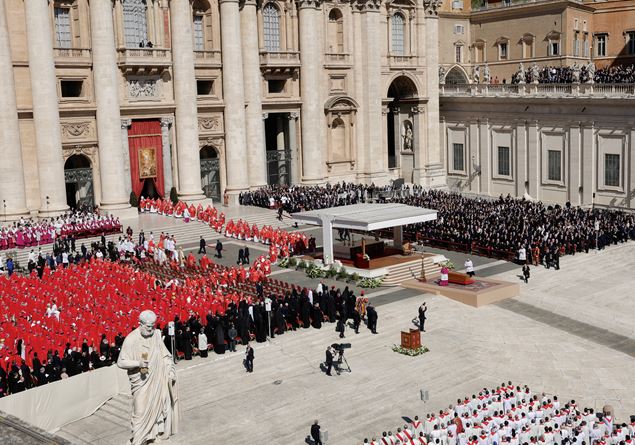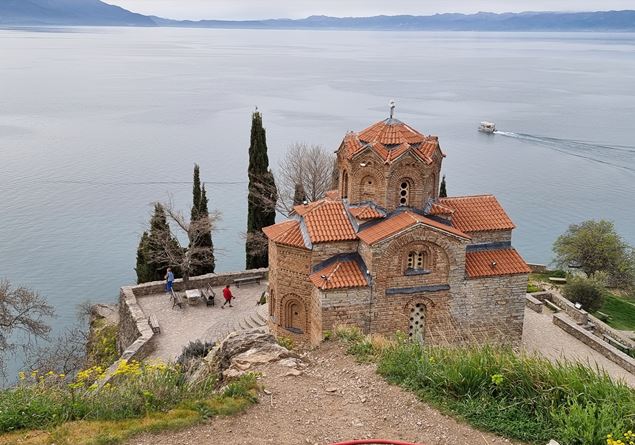Text and photos of Roberto Di Diodato and Mary Poliafico
Ohrid, Macedonia.
Easter, a big spring party, will be celebrated this year by all Christian churches in the world on the same date of April 20. Being in Ohrid, a city and a mysterious lake in Northern Macedonia, would mean for the tourist to be enchanted by the magnificent and spectacular liturgies in the orthodox basilicas of the ancient urban center, by the warmth of its beaches and the extraordinary sacred stories frescoed in its numerous he asked. All just a couple of hours of flight from Milan.
The Drin river comes from far away, from the mountains of Kosovo or perhaps even further up. It is the only and faithful tax of Lake Ohrid, a very ancient lake basin in the Balkans, lying between Albania and Macedonia, fueled above all by powerful underground sources. A little smaller than our Garda, he was declared a World Heritage Site by UNESCO for the many endemisms of the fish fauna, for the enchanted naturalistic beauty that surrounds him and for the preciousness of his artistic and cultural history. More unique than rare case.
Ohrid is the lake you don’t expect. After traveling from Tirana, Albania, for a few hours on densely demanding road roads and having crossed a border pass, you enter the North Macedonia passing through a desolate customs between swarm and whirlwind mountains. The lake appears with the sweetness of a truce.
Small and very light boats cross it and skirt it. The clear and crystalline waters such as those of an alpine lake, where to throw the tangles and contortions of everyday life, let them dream great peace and infinite rest. The town that gives it its name also maintains the scent of a lake mountain village. Street roads in ups and downs, stone flooring and arches, hidden squares, traditional Ottoman houses, a lakefront overlooking the craft shops, welcoming and discreet bars and restaurants. And some beaches: Golden Beach, Lagadin, Gorica Beach and Orevche Beach. Climbing on the side of a hill and crowned by mighty medieval walls with eighteen towers and four doors, Ohrid has had a politically glorious past. In the tenth century it was the capital of the first Bulgarian Empire, governed by Tsar Samuele I. But an “relic” of an even older past is its magnificent Hellenistic theater, dating back to 200 BC., When these territories were under the influence of the conquests of Alexander the Great. Today the classic elegance of the architectural complex acts as a cradle of numerous theatrical and musical events of national and international level.
Equally illustrious is the story of Ohrid as the “beating heart” of Christian culture and art. In the past it was called “Jerusalem of the Balkans” because it was said to have 365 churches, one for each day of the year. Even today it preserves majestic basilicas, numerous Orthodox churches and monasteries, which shine with works of immense value. In the old city, the ancient religious buildings are rejuvenated by the colors of hieratic frescoes such as those of the Holy Mother of God Bolnichka, Santa Sofia, Santa Maria Kamensko, St. Nicholas Bolnichki and Holy Mother of God Peribleptos. In the latter sacred building you can admire the pictorial works of Michael Astrapas and Eutychio da Tesalonica, two great interpreters of the “Renaissance” of Byzantine art under the dynasty of the emperors paleologists; In the same architectural complex, an “icon museum” was opened, which exhibits thirty jewels of Orthodox iconography.
The banks of Lake Ohrid brought the first writing of the Slavic language with the characters of the Cyrillic alphabet, a cultural event of great historical relevance in the formation of the social and religious identity of the Slavic language peoples. Scholars agree that this alphabet was created by San Clemente in its Ohrid monastery by modifying the Glagolitic one, invented by the Saints Cyril and Methodium. Today the convent of San Clemente and Pantaleone is part of the archaeological complex of Plaosnik located just under the medieval walls of the city. In the shade of his cloisters, the first University of the Balkans was born, frequented by thousands of students, where he taught himself to write and pray.
The most iconic image, which remains indelible in the retina of memory, is the one that offers the church of St. John Theologian, a wonder overlooking the lake, a hymn to the seductive harmony of nature that embraces art and protects it , a temple that seems to have come out of the hands of an Armenian architect. It is the emblem of Ohrid and the whole Macedonia. It can be reached by walking on a wooden catwalk that winds between rock and water. In the return, the shelter of boats and boat waiting to take off. The interior of the sacred building is small and collected. An iconostas of golden icons breaks silence. John Venerato is the fourth evangelist, author of the apocalypse.
Instead, he has the appearance of a Byzantine matron Santa Sofia, aware of being the Basilica Bella, the Regina Church, crowned with arcades and colonnades. Its foundation dates back to the 10th century, at the time of the Bulgarian Empire which extended over most of the Balkan territories south of the Danube. Its antiquity and importance are certified by the frescoes of the apse cap, where six Popes of the Roman Church are depicted, reigning before the “great schism” of 1054, when the Eastern Orthodox Church separated from the Western Catholic Church. On the walls numerous paintings with theories of saints, patriarchs, bishops and priests of the Orthodox tradition.
Thirty kilometers south of Ohrid, just five from the border with Albania, the last amazement that Northern Macedonia leaves as a memory to tourists, visitors and faithful believers. The monastery of San Naum stands on the banks of the lake. Cittadella Santa placed on a hill. A large park and a lagoon surrounded by a lush forest are placed around. Boats at the Fonda. Cigni, ducks and some peacocks complete the idyllic vision of this paradisiac corner, where the source that feeds the lake flows. The Church, where the Holy Founder Munich is buried, is a favors studded with frescoes. The ascension of Naum is depicted above the tomb. A precious pictorial cycle narrates, with the naive freshness resembling that of the “Franciscan Fioretti”, life scenes and amazing miracles operated by the saint: “harness the bear at the plow”, “the bucket leaves a hole in the stone”, “Healing of the mentally ill”, “the horse thief on the door of the church of the monastery” … many spaces are crowded with representations of Orthodox saints, starting with Cirillo and Methodius.
Ohrid “Pearl of the Balkans” is not just a hyperbolic image. The city and its lake really have to do with pearls. They are true, produced exclusively here, with a very unusual process that has been handed down from father to son. Unlike normal pearls, these do not collect but are produced using some types of shells and the scales of the scarecrow fisha species that lives only in this lake. Covered by a rigorous secret is the composition of the emulsion that allows you to mix the mixture and give it the shape of balls of various sizes, ready to become jewels. Ohrid’s pearls are “forever”, as a television advertising slogan says. The same thing affirm local producers. What is certain is that in recent decades these timeless preciousness have been appreciated everywhere. Lady Diana also wore them. Today they have become a “trademark” that conveys the knowledge of Macedonia all over the world.
Meta of a selective tourism that knows how to enjoy and move the shy beauty of arcane and desuel places, Ohrid is a concentrate of peace and serenity, unique in Europe. Better to go there immediately, before everyone realizes his existence.
Hotel Lagadin (between lake and mountains): 00389.46285227, ohrid, mail: [email protected]









